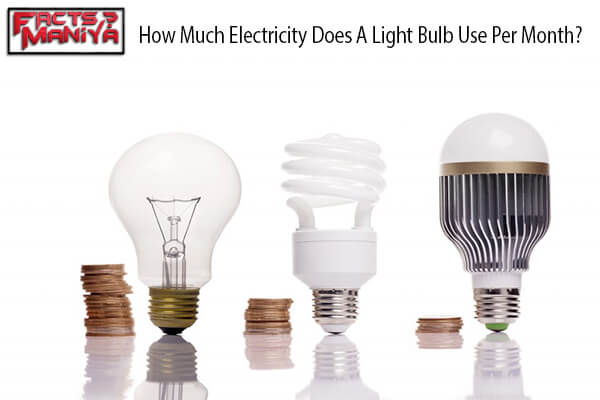Here we start all about How Much Electricity Does A Light Bulb Use Per Month? According to the energy use table, an LED light bulb uses only seven to ten watts, a fluorescent light bulb uses sixteen to twenty, and an incandescent light bulb typically uses sixty watts and costs roughly 0.6 cents an hour to operate.
How Much Electricity Does A Light Bulb Use Per Month?
Depending on the size and type, light bulbs typically consume 2 to 100 watts (W) of electricity. LED bulbs consume 2 to 18 W, while conventional incandescent lamps need 25 to 100 W.
Light bulbs typically draw less than 1 amp and 110 volts. The most significant factor affecting how much electricity a light bulb uses over life is how often you use it; in American households, lights are often left on for around 2 hours daily.
Using a typical 60 W incandescent bulb as an example: Your light bulb consumes 0.42 kilowatt-hours (kWh) each week, 1.83 kWh per month, and 21.9 kWh annually when used for one hour per day. The energy used by a light bulb for two hours per day equals 0.84 kWh each week, 4.38 kWh annually, and 3.65 kWh each month.

On the high end, 1.26 kWh per week, 5.48 kWh per month, and 65.7 kWh annually are used when a light bulb is left on for three hours per day. Here is an example of how much energy you might use with an LED bulb that uses less electricity (often 10 W):
- One hour per day of LED light bulb use results in electricity consumption of 0.07 kWh per week, 3.65 kWh per year, and 0.30 kWh each month.
- Using an LED light bulb for 2 hours per day results in a consumption of 0.14 kWh per week, An average of 0.61 kWh every month, or 7.30 kWh per year.
- On the high end, operating an LED bulb for three hours daily consumes 0.21 kWh per week and 0.92 kWh per month.
Remember that it’s uncommon to turn on the lights with just one light bulb. To obtain a more accurate energy use estimate, multiply any of the values above by the number of light bulbs you might switch on in a room or across your home.
Over a year, different light bulbs’ electricity use varies. If you keep a light bulb on for an average period (2 hours per day, adding up to 730 hours per year). Consumers can choose from three basic types of light bulbs:
- Incandescent bulbs: The majority of us were raised using these bulbs. The standard, conventional light bulb. They only last a little while and could be more effective.
- Compact fluorescent light bulbs (or CFLs): When we think of energy-efficient light bulbs, many of us picture these “spiral-y” bulbs.
- LED bulbs: Also known as “light emitting diodes,” these bulbs are incredibly energy-efficient while retaining the design and appearance of the traditional incandescent bulb.
Each of them uses a different amount of energy, as you could expect. Now, each bulb is separate when it comes to wattage. Any 1000-watt bulb will consume the same amount of power. However, 1000 watts will provide a completely different amount of light in each light bulb.
Therefore, you must consider each type’s brightness when comparing them. To simplify the math, let’s look at 100 watts for this computation. We’ll compare lights that are on continuously for a whole year at similar brightness settings. This exercise is meant to assist you in comparing the efficacy of different bulbs, not to provide precise data. The cost of a kWh of electricity will also be assumed to be 15 cents.
- Incandescent: A 100-watt conventional light bulb would consume 876 kWh of energy if left on all year. You’ll need to change that bulb regularly (about 12 times yearly).
- CFL: A 25-watt CFL bulb has the same brightness as a 100-watt incandescent bulb. This would only consume 216 kWh of electricity each year. Large savings. And it would probably only need to be replaced twice.
- LED: You need a 16-watt LED bulb to provide the same brightness. The bulb would last the entire year on that energy, or 140 kWh.
Conclusion
You should know How Much Electricity Does A Light Bulb Use Per Month? Keep one lightbulb on for a year and consume 712 pounds of coal, 145 pounds of natural gas, or .0439 pounds of uranium. No, that isn’t worth it. All we can do is make an effort to use as little energy as possible, but power is still necessary.

